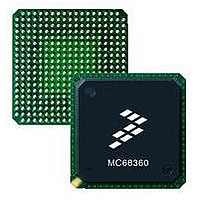MC68EN360CAI25L Freescale Semiconductor, MC68EN360CAI25L Datasheet - Page 924

MC68EN360CAI25L
Manufacturer Part Number
MC68EN360CAI25L
Description
IC MPU QUICC 25MHZ 240-FQFP
Manufacturer
Freescale Semiconductor
Series
MC68000r
Datasheets
1.MC68EN302AG20BT.pdf
(8 pages)
2.MC68EN360VR25L.pdf
(14 pages)
3.MC68EN360VR25L.pdf
(2 pages)
4.MC68EN360CAI25L.pdf
(962 pages)
Specifications of MC68EN360CAI25L
Processor Type
M683xx 32-Bit
Speed
25MHz
Voltage
5V
Mounting Type
Surface Mount
Package / Case
240-FQFP
Core Size
32 Bit
Cpu Speed
25MHz
Embedded Interface Type
SCP, TDM
Digital Ic Case Style
FQFP
No. Of Pins
240
Supply Voltage Range
4.75V To 5.25V
Rohs Compliant
Yes
Family Name
M68xxx
Device Core
ColdFire
Device Core Size
32b
Frequency (max)
25MHz
Instruction Set Architecture
RISC
Supply Voltage 1 (typ)
5V
Operating Supply Voltage (max)
5.25V
Operating Supply Voltage (min)
4.75V
Operating Temp Range
-40C to 85C
Operating Temperature Classification
Industrial
Mounting
Surface Mount
Pin Count
240
Package Type
FQFP
Lead Free Status / RoHS Status
Lead free / RoHS Compliant
Features
-
Lead Free Status / Rohs Status
Compliant
Available stocks
Company
Part Number
Manufacturer
Quantity
Price
Company:
Part Number:
MC68EN360CAI25L
Manufacturer:
APLHA
Quantity:
12 000
Company:
Part Number:
MC68EN360CAI25L
Manufacturer:
Freescale Semiconductor
Quantity:
10 000
Part Number:
MC68EN360CAI25L
Manufacturer:
FREESCALE
Quantity:
20 000
- MC68EN302AG20BT PDF datasheet
- MC68EN360VR25L PDF datasheet #2
- MC68EN360VR25L PDF datasheet #3
- MC68EN360CAI25L PDF datasheet #4
- Current page: 924 of 962
- Download datasheet (4Mb)
RISC Microcode from RAM
This controller only performs the lowest layers of the SS7 protocol stack. The upper layers
must be performed in software by the CPU in the system. The software to perform the upper
layer protocol is available from third party providers.
The SS7 controller contains the following key features:
C.1.1 Performance
At 25Mhz, an aggregate SS7 bandwidth of 6 Mbps divided among the 4 SCCs consumes
100% of the processing power of the RISC communications engine. If only a percentage of
the total available SS7.
bandwidth is used, the remaining RISC processing power can be used to run other protocols
on other channels. Table C-1 shows possible QUICC configurations.
C-2
• Uses either NMSI or TDM interface and a variety of data encoding schemes.
• Flexible data buffers with multiple buffers per signal unit allowed.
• Separate interrupts for received signal units and transmitted buffers.
• Maintenance of good frame counter, bad frame counter, and SU Error Monitor.
• Standard HDLC features:
—Flag/Abort/Idle generation/detection
—Zero insertion/deletion
—16-bit CRC-CCITT generation/checking
—Detection of non-octet aligned signal units
—Programmable number of flags between signal units
—Detection of long SUs.
—Discard short (less than 5 octets) signal units.
—Automatic Fill-In Signal Unit transmission.
—Automatic Link Status Signal Unit retransmission.
—Automatic discard of identical FISUs and LSSUs.
—Octet Counting Mode support.
—Command to force a reset of filtering state.
—Command to force entry into octet counting mode.
—Ability to permanently disable octet counting mode.
—Ability to disable FISU and LSSU filtering.
—Ability to force entry into octet counting mode if a receiver overrun occurs.
—Consumes 1280 bytes of the QUICC’s internal memory.
SS7 Channels
1 x 64 Kbit/s
2 x 64 Kbit/s
3 x 64 Kbit/s
Freescale Semiconductor, Inc.
Risc Bandwidth
Consumed (est)
For More Information On This Product,
Table C-1. SS7 Configuration
1%
2%
3%
MC68360 USER’S MANUAL
Go to: www.freescale.com
1 x 10 Mbit Ethernet, 2 x 2.048 Mbit HDLC
2 x 4 Mbit HDLC, 2 x 19.2 Kbit SMC UART
1 x 6 Mbit HDLC, 2 x 19.2 Kbit SMC UART
Possible Configuration of Other Channels
Related parts for MC68EN360CAI25L
Image
Part Number
Description
Manufacturer
Datasheet
Request
R
Part Number:
Description:
Manufacturer:
Freescale Semiconductor, Inc
Datasheet:
Part Number:
Description:
Manufacturer:
Freescale Semiconductor, Inc
Datasheet:
Part Number:
Description:
Manufacturer:
Freescale Semiconductor, Inc
Datasheet:
Part Number:
Description:
Manufacturer:
Freescale Semiconductor, Inc
Datasheet:
Part Number:
Description:
Manufacturer:
Freescale Semiconductor, Inc
Datasheet:
Part Number:
Description:
Manufacturer:
Freescale Semiconductor, Inc
Datasheet:
Part Number:
Description:
Manufacturer:
Freescale Semiconductor, Inc
Datasheet:
Part Number:
Description:
Manufacturer:
Freescale Semiconductor, Inc
Datasheet:
Part Number:
Description:
Manufacturer:
Freescale Semiconductor, Inc
Datasheet:
Part Number:
Description:
Manufacturer:
Freescale Semiconductor, Inc
Datasheet:
Part Number:
Description:
Manufacturer:
Freescale Semiconductor, Inc
Datasheet:
Part Number:
Description:
Manufacturer:
Freescale Semiconductor, Inc
Datasheet:
Part Number:
Description:
Manufacturer:
Freescale Semiconductor, Inc
Datasheet:
Part Number:
Description:
Manufacturer:
Freescale Semiconductor, Inc
Datasheet:
Part Number:
Description:
Manufacturer:
Freescale Semiconductor, Inc
Datasheet:











